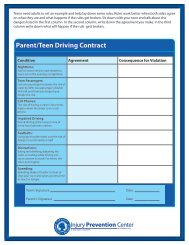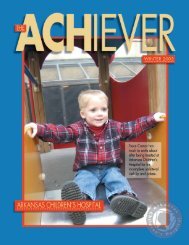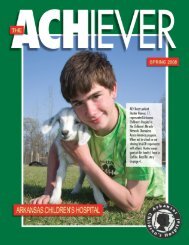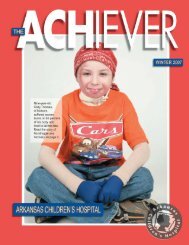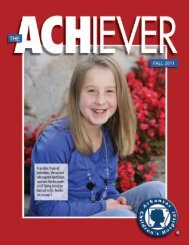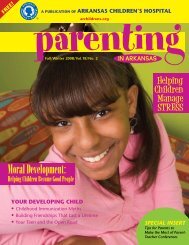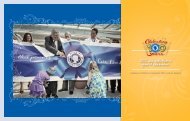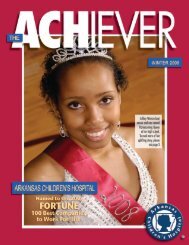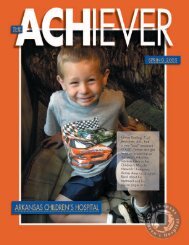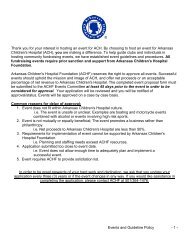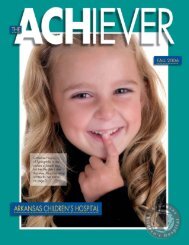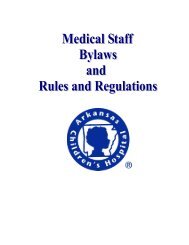Winter 2008 - Arkansas Children's Hospital
Winter 2008 - Arkansas Children's Hospital
Winter 2008 - Arkansas Children's Hospital
- No tags were found...
You also want an ePaper? Increase the reach of your titles
YUMPU automatically turns print PDFs into web optimized ePapers that Google loves.
HOSPITAL NEWSECMO Program at ACH Recognized InternationallyECMO (Extracorporeal Membrane Oxygenation) is a cardiorespiratorysupport system that can be used in critical care situationswhen a patient’s heart or lungs are failing with such severity that typicalintensive care support is not adequate to keep the patient alive.ECMO essentially provides long-term heart/lung bypass, taking thework off the heart and lungs.<strong>Arkansas</strong> Children’s <strong>Hospital</strong>’s ECMO program recently receivedthe Excellence in Life Support Award from the Extracorporeal LifeSupport Organization (ELSO). ELSO is an international organizationof centers that offer ECMO.The ECMO program at <strong>Arkansas</strong> Children’s <strong>Hospital</strong> is one ofthe busier programs in the United States, supporting approximately40-50 patients yearly and operating a mobile ECMO unit, one ofonly three mobile systems in the country. Mobile ECMO systemsallow the transport of critically ill patients, either by air or ground,while the patient is on ECMO bypass. The ECMO program at ACHbegan in 1989 and is one of the oldest programs in the nation.<strong>Arkansas</strong> Children’s <strong>Hospital</strong> was presented the Excellence inLife Support Award for its exceptional commitment to providinga quality ECMO program, staff training, continuing educationand ongoing clinical research.“This award is a tremendous honor and reflects many years ofhard work by a very large number of people. Our ECMO teamcontinually strives to better serve the needs of the most criticallyill infants and children across our state and region,” says Dr.Richard T. Fiser*, co-medical director of the ECMO program atACH. “The strength of our program would not be possible withoutthe broad, on-going support we receive from the hospital.”*Richard T. Fiser, M.D., FAAP, is co-medical director of the ECMOprogram at ACH and associate professor of pediatrics, UAMSCollege of Medicine.INJURY PREVENTION CENTERContinued from page 6The community outreach department at ACH has been educatingpeople about injury prevention techniques, such as seat belt andcar seat safety, for years, and will continue to be a partner to thecenter.One issue staff members know will be an ongoing challenge isgetting parents and children to buckle their seat belts while in a car.In <strong>Arkansas</strong>, a child dies every 2.5 days from injuries sustained in amotor vehicle crash, making it the leading cause of unintentionalinjury death among children, with infrequent car seat and seat beltuse a strong factor.To boost and sustain the safety initiatives promoted by the center,staff members will attempt to generate community-level supportfor many programs, including teen driving and helmet use.“One of our goals is to provide a concentrated injury preventionapproach so that people will hear about it again and again –because they need to,” says Dr. Aitken.Dr. Aitken, a pediatrician, and Davis, a former law enforcementofficer, think their backgrounds will help with their activities at theInjury Prevention Center.“As a law enforcement officer, Richard was at the scene of manycar and ATV crashes involving young children,” Dr. Aitken says.“As a pediatrician, I see the consequences of these crashes in thechildren’s injuries. Our backgrounds help us understand exactlywhat we are dealing with when it comes to injury prevention.”Davis agrees. “I noticed when I was in law enforcement that somany accidents are preventable. It made me shake my head andwonder, ‘Why didn’t they take a few seconds to buckle up? Or puton a helmet?’ Some of these accidents are so easily prevented if wecan just get people to take simple steps.”For more information on the Injury Prevention Center, contact(501) 364-3400.*Mary Aitken, M.D., M.P.H., is medical director of the InjuryPrevention Center, staff physician at ACH and associate professor,department of pediatrics, UAMS College of Medicine.Unintentional Injury Death Rate,Children 0-19 Years, 1990-2004Centers for Disease Control and Prevention, National Center for Injury Prevention and Control.Web-based Injury Statistics Query and Reporting System (WISQARS) [online]. (2005) [cited2007 Feb 7]. Available from URL: www.cdc.gov/ncipc/wisqarsIn <strong>Arkansas</strong>, injury death rates are well above the nationalaverage. For children aged 0-19 years, unintentional injuryhappens 84 percent more often than across the nation. Theseare the dramatic numbers the Injury Prevention Center is tryingto reverse.7



